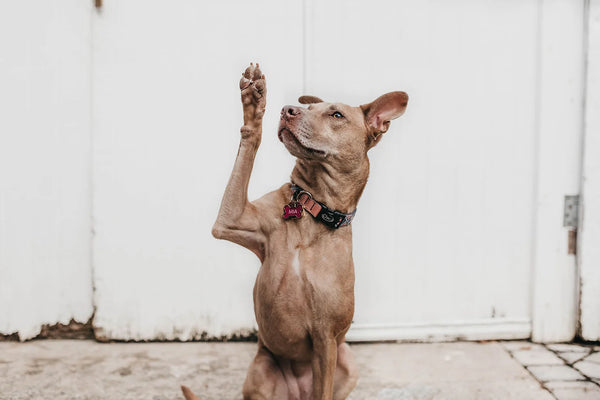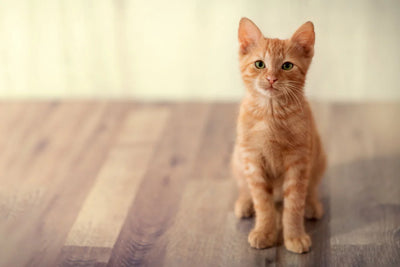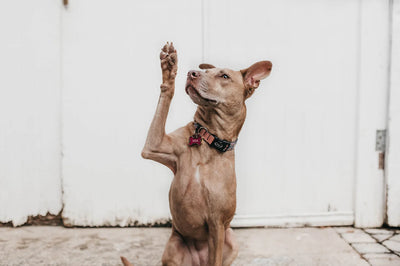Why do dogs wag their tails? Why do they show us their bellies? Your woofer’s mind might feel like a mystery, but it’s actually quite easily understood by looking at their body language. We dive into your dog’s gestures and what they mean.

Although our woofers may not speak English (with the exception of howling huskies), they do communicate with us: when they stare intently at our dinner we know they want some, and when they wag their tail as we approach the lead we know they’re excited.
Although sometimes it might not feel as if they’re listening (for example, after the fifth time you ask them to sit), dogs are actually very expressive animals. By learning about your dog’s gestures and what they mean, you can fine-tune training and double down on playtime. Besides, they learn our language (some better than others), it’s only fair that we learn theirs too.
Learning your dog’s gestures and what they mean helps you understand each other better. It means that next time your woofer’s belly up and looking at you expectantly, you know to follow their lead and give them belly rubs.
If you’re wondering why do dogs wag their tails? Or what does it mean when their dog ears go back? You’re in the right place. We’re going to explain your dog’s gestures and what they mean.
Their tail
No two tail wags are the same. People often misinterpret dog tail meanings. Instead of asking, ‘Why do dogs wag their tails?’ Many assume a wagging tail is a sign of happiness. In reality, your dog’s tail wag can mean a few different things. The rigidity and pace of your pup’s tail wag is the best way to work out their mood.
Fast and lose tail wag
Why do dogs wag their tails? A fast and loose wag usually means your woofer is happy and excited. You’ve likely seen it accompanied by whole body wobbles when your pooch spots you first thing in the morning or when you come through the front door after a long day apart. A fast and loose wag means it’s time to play! Tail wagging can also be paired with panting, which signals your dog is excited or out of breath. 
Tail standing tall
Dog tail meanings don’t stop there. If your dog’s tail is rigid and upright, it means they’re alert. Your woofer’s tail will usually stand tall if they’re curious, unsure, or want to assert their dominance.
If you’re still unsure of your dog’s gestures and what they mean, look at the surrounding context. If you’re introducing them to your neighbour’s new puppy, they might be asserting their dominance, whereas if you’re opening a food packet, they’re likely alert and watching to see what emerges (they’re in for a treat!).
If your dog’s nose and stance tilt forward with their tail pointing upright, they’re likely suspicious and weighing up the new thing in the room – the broom or your next-door neighbour’s cat – assessing if it’s a threat.

Tail between legs
Of all the dog tail meanings to decipher, it’s important to recognise when your pooch has their tail between their legs. This signifies your dog is sad or scared. Again, context is important.
If you’ve just told them off for running away with your socks, it isn’t a huge concern, but if they’re doing it constantly or their other gestures – like big whale eyes and lowered ears – suggest they’re seriously scared, make sure you assure them that they’re safe. For some dogs safe means a snuggle with their bestie, for others it means giving them space, do what’s best for your pup.
Their ears
Every dog’s ears are different, but regardless of their breed and size, your hound’s ears give you a lot of insight into how they’re feeling.
Ears upright
Upright ears signify an alert dog. They signify your hound is listening intently. They might be taking in new circumstances, or excited and ready to play.
Ears pulled back
What does it mean when dog ears go back? If your dog’s ears are pressed back against their head, they’re likely worried or scared. Dogs put their ears back to protect themselves from a potential threat. This behaviour is an instinctual response if they’re feeling anxious or distressed. If your dog has low hanging ears and their mannerisms are harder to detect, look at the base of their ears to see how they’re feeling.
To complicate things, dogs also lower their ears when they’re feeling friendly. This is why they lower their ears when they’re receiving a scratch on the couch or giving you a loving lick to the face (lucky you!). Here, their ears aren’t fully pressed against their head, just lowered down (to make room for scratches!).
If you’re still wondering ‘What does it mean when dog ears go back?’, we’re not surprised. These two mannerisms seem similar, but when considered together with other movements, you can easily decipher how your dog is feeling.
If your woofer is avoiding eye contact, has their tail between their legs and their ears pressed against their head, they’re feeling distressed. This could be because they just got a talking to for barking at the neighbours, or because there’s another dog in the room. If your canine has their eyes back and tail wagging, they’re happy (it might be because you’re giving them the scratch of their dreams!)
Their eyes
When it comes to deciphering your dog’s eye movements, they’re very similar to hoomans. They avoid eye contact when they’re in trouble and hold eye contact when they’re focused or challenging you. You’re probably already interpreting your dog’s eye contact, you just haven’t realised.
Avoiding eye contact
Just like hoomans, hounds avoid eye contact when they’re trying to steer clear of confrontation. Avoidance of eye contact is your doggo expressing their discomfort at a situation, it’s a non-confrontational, submissive gesture.
You’ve likely witnessed this when you’ve told your dog off for digging in the backyard, and watched them skulk away with their ears back, avoiding eye contact. Their body language in these circumstances says ‘please fur-give me’; they’re worried and trying to soothe the situation.
Heavy eye contact
Heavy eye contact can mean a few different things depending on your dog’s body language. Your woofer’s either really keen on the sandwich you’re eating, or they’re alert and potentially feeling aggressive. Consider the other body language they’re displaying to determine how they’re feeling, and act accordingly. If your dog is showing signs of aggression, don’t stare or hold eye contact, as this will be interpreted as a threat. In these moments, give your dog space.
Whale eyed dogs
If you can see the whites of your dog’s eyes, or they look wide and glassy, this is called whale eyes. Dogs are similar to hoomans – their eyes widen when they’re surprised or scared.
When considering this dog gesture and what it means, consider your dog’s other mannerisms. Are they just taking in their surroundings or are they genuinely frightened?
Their mouth
Bared teeth
If your woofer has bared teeth accompanied by an upright, stiff tail, raised hackles (raised hair along their back) and a hard stare, they’re showing signs of aggression. Step back, avoid eye contact and give your dog space – they’re feeling seriously threatened. If this behaviour continues, consult a qualified dog trainer or behaviourist and veterinarian.
Their body
Sometimes your hound will use their whole body to show you how they’re feeling (like when they get the whole-body wobbles).
Head down, rear end up
If your pupper has their front legs down and tail end up, they’re ready to play. It’ll likely be accompanied by a wagging tail as they focus their attention on the toy you’re tugging or the ball you’re about to throw.

Belly up
To fully understand your dog’s gestures and what they mean, you need to recognise the two instances when your dog will show their stomach. There are two scenarios where your doggo will show their tummy: when they’re giving a submissive gesture, or when they’re ready for belly rubs. Your dog’s stomach is close to their organs, so their natural instinct is to protect them.
When your furry friend flops onto the floor and puts all four paws in the air with their tail wagging, they’re showing you they trust you, or, they want a scratch. Because your woofer will always try to protect their stomach, revealing it means they trust you and they’re comfortable in your presence.
When your doggo is belly up, consider the circumstances. If their tail’s wagging and you’re in a safe and relaxing environment, they’re showing you they’re happy or want a scratch (belly rubs are canine kryptonite).

The other circumstance where you might see your canine’s belly is when they’re submitting to another person or dog. When this happens, your woofer will typically avoid eye contact and roll over onto their back. This signifies to another dog that they aren’t a threat.
Be wary of trying to pet your dog in these circumstances. They’re in a vulnerable position, so they might view you reaching down to pat them as an attack.

Head tilt
Wondering what it means when your hound tilts their head slowly from side to side? They’re thinking and listening. Some dogs tilt when they’re processing something new, like hearing the sound of the vacuum cleaner, others tilt when you’re talking to them (as if they’re translating from English to dog). A head tilt signals an engaged and curious hound.
Every dog is different
When you’re deciphering your dog’s gestures and what they mean, keep in mind that it’s not one size fits all. When you’re working out how your dog is feeling, remember to consider the context. Take in the surrounding circumstances, and note their gestures as a whole, not as isolated body movements. With a little patience and practice, you’ll be well on your way to becoming the neighbourhood dog whisperer.
We love hearing about the weird and wonderful ways your woofer communicates with you. Whether they paw at you when it’s time for a pat or howl when you get home, we want to hear about it. Jump over to our Instagram or Facebook and join the pack.



